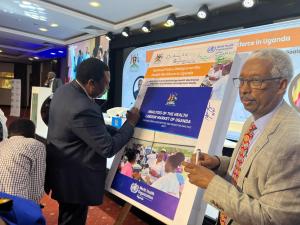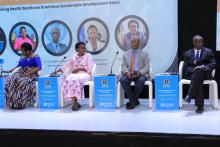Health experts discuss work force investments and optimization in Uganda
The Uganda Ministry of Health, in collaboration with the World Health Organization (WHO), convened a two-day National Policy dialogue on investing in and optimizing the health workforce to achieve Sustainable Development Goals (SDGs) in Uganda.
The dialogue provided an opportunity for policymakers, health planners and partners to discuss and adopt appropriate solutions for addressing the health workforce challenges in Uganda.
Adequate number and skill mix of equitably distributed health workforce, are critical to achieving national health goals, universal health coverage (UHC) and the health-related SDGs targets. Ensuring adequate number and equitable distribution of human resources for health require ready access to quality data and their use to inform evidence-based health and health workforce policy and plans in countries.
Last year, WHO supported the Ministry of Health to undertake the Health Labour Market Analysis (HLMA), to better understand the human resources for health dynamics in Uganda. The analysis, part of whose findings were discussed during the dialogue, provides an in-depth assessment of the relationship between political economy, education, supply, demand, and the overall need related to health workers in Uganda.
Findings from the HLMA indicate that Uganda has an estimated need for health workers of 342,832 compared to an overall supply of 154,016. This translates to 44.9% of the need for health workers being available.
Speaking at the opening of the policy dialogue, Dr. Jane Ruth Aceng, Uganda’s Minister of Health urged stakeholders to use the findings to inform Human Resources for Health development interventions while advancing the country’s health agenda.
“There are efforts to ensure we have adequate and skilled human resources in the health sector but the efforts are not yet to the extent desirable. We continue exploring evidence-based strategies and policies to address the challenges,” she said.
In 2022, Uganda had a total of 210 health training institutions across 66 districts. The total stock of health workers in Uganda was estimated at 158,932 in 2022 with a density of 25.9 doctors, nurses, and midwives per 10,000 population. The public health sector wage bill in Uganda has increased by 15% between the 2018/2019 and 2022/2023 Financial years.
Dr. Yonas Tegegn Woldemariam, WHO Representative to Uganda applauded the Government of Uganda’s commitment to strengthening the health system to realize universal health coverage target.
“Ranging from increased allocations to more investment in health infrastructure, and improved health worker remuneration, it is evident that the country is on the right track to achieve universal health coverage targets by 2030,” he said.
The participants acknowledged that investing in the health workforce requires a whole-of-society and whole of government approach. This approach relies on multi-sectoral collaborations among government ministries, departments and agencies, development partners and the private sector.
Communications Associate
WHO Uganda Country Office
Email: afwcougcom [at] who.int (afwcougcom[at]who[dot]int)
Phone: +256740487734
Communications Officer
WHO Uganda
Email: tcheutchouae [at] who.int (tcheutchouae[at]who[dot]int)



